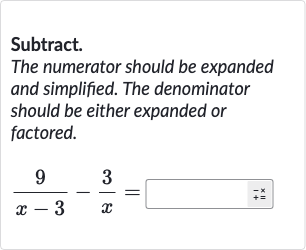Full solution
Q. Subtract.The numerator should be expanded and simplified. The denominator should be either expanded or factored.
- Identify common denominator: Identify the common denominator for the two fractions.To subtract the fractions and , we need a common denominator. The common denominator will be the product of the two distinct denominators, which are and .Common Denominator:
- Rewrite fractions with common denominator: Rewrite each fraction with the common denominator.We need to adjust each fraction so that they both have the common denominator. This means multiplying the numerator and denominator of each fraction by the term that is missing from its current denominator. becomes becomes
- Expand numerators of new fractions: Expand the numerators of the new fractions.Now we expand the numerators of both fractions to simplify the subtraction. becomes becomes
- Subtract second fraction from first fraction: Subtract the second fraction from the first fraction.Now that both fractions have the same denominator, we can subtract the numerators directly.
- Simplify numerator of resulting fraction: Simplify the numerator of the resulting fraction.We need to distribute the negative sign in the numerator and combine like terms.So the simplified numerator is .
- Write final simplified fraction: Write the final simplified fraction.The final simplified fraction with the common denominator and simplified numerator is:
More problems from Negative Exponents
QuestionGet tutor help



